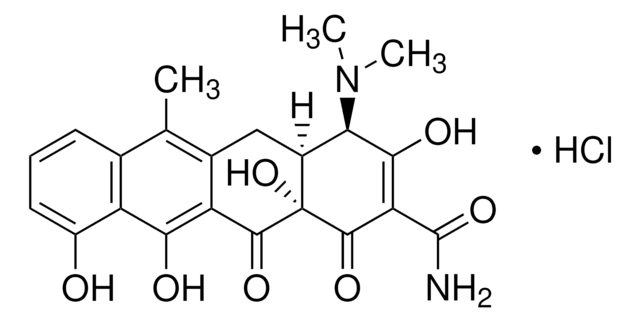28-1320
Silbernitrat
SAJ first grade, ≥99.8%
Synonym(e):
Salpetersäure Silber(I)-salz
About This Item
Empfohlene Produkte
Qualität
SAJ first grade
Dampfdichte
5.8 (vs air)
Assay
≥99.8%
Form
solid
Verfügbarkeit
available only in Japan
mp (Schmelzpunkt)
212 °C (dec.) (lit.)
Lagertemp.
15-25°C
SMILES String
[O-][N+]([O-])=O.[Ag+]
InChI
1S/Ag.NO3/c;2-1(3)4/q+1;-1
InChIKey
SQGYOTSLMSWVJD-UHFFFAOYSA-N
Suchen Sie nach ähnlichen Produkten? Aufrufen Leitfaden zum Produktvergleich
Anwendung
- In Situ Fabrication of Silver Nanoparticle-Decorated Polymeric Vesicles for Antibacterial Applications.: This article discusses the use of silver nitrate in the synthesis of polymeric vesicles decorated with silver nanoparticles, aimed at enhancing antibacterial properties. This approach represents a significant advancement in the development of targeted antibacterial therapies, showcasing the role of silver nitrate in the field of medical materials science (Zhang et al., 2024).
- Impact of Metal Salt Oxidants and Preparation Technology on Efficacy of Bacterial Cellulose/Polypyrrole Flexible Conductive Fiber Membranes.: This study leverages the oxidizing properties of silver nitrate to enhance the conductivity and flexibility of polymeric fiber membranes. The findings contribute to advancements in wearable electronics and sensors, demonstrating the versatility of silver nitrate in engineering applications (Tao et al., 2024).
- Control of the Hydroquinone/Benzoquinone Redox State in High-Mobility Semiconducting Conjugated Coordination Polymers.: This paper presents the use of silver nitrate in controlling redox states in semiconducting polymers, highlighting its crucial role in the development of high-performance electronic materials. The research underscores the application of silver nitrate in enhancing the electrical properties of novel polymeric materials (Huang et al., 2024).
Signalwort
Danger
H-Sätze
Gefahreneinstufungen
Aquatic Acute 1 - Aquatic Chronic 1 - Eye Dam. 1 - Met. Corr. 1 - Ox. Sol. 2 - Repr. 1B - Skin Corr. 1A
Lagerklassenschlüssel
5.1B - Oxidizing hazardous materials
WGK
WGK 3
Flammpunkt (°F)
Not applicable
Flammpunkt (°C)
Not applicable
Analysenzertifikate (COA)
Suchen Sie nach Analysenzertifikate (COA), indem Sie die Lot-/Chargennummer des Produkts eingeben. Lot- und Chargennummern sind auf dem Produktetikett hinter den Wörtern ‘Lot’ oder ‘Batch’ (Lot oder Charge) zu finden.
Besitzen Sie dieses Produkt bereits?
In der Dokumentenbibliothek finden Sie die Dokumentation zu den Produkten, die Sie kürzlich erworben haben.
Unser Team von Wissenschaftlern verfügt über Erfahrung in allen Forschungsbereichen einschließlich Life Science, Materialwissenschaften, chemischer Synthese, Chromatographie, Analytik und vielen mehr..
Setzen Sie sich mit dem technischen Dienst in Verbindung.







